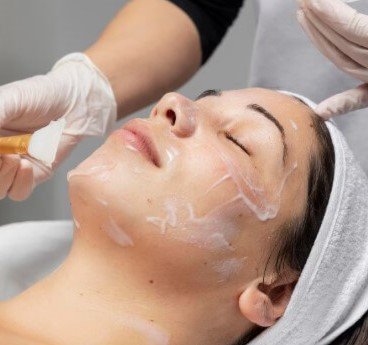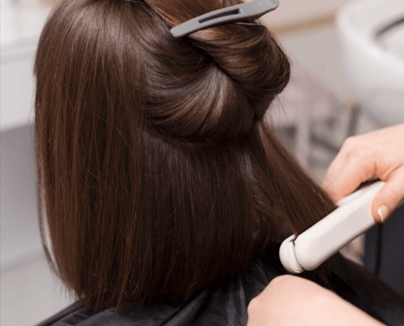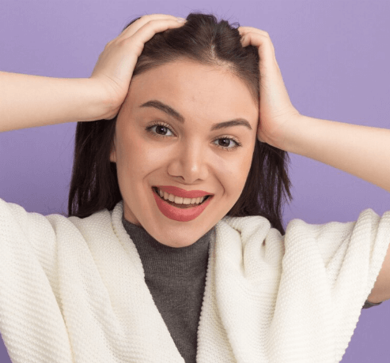Treatment Overview
The Mandelic Acid Peel is a gentle Alpha Hydroxy Acid (AHA) peel derived from bitter almonds. Compared to glycolic or lactic acid, mandelic acid has a larger molecular size, which allows it to penetrate the skin more slowly and evenly, making it one of the safest peels for sensitive and PIH-prone skin.
In Korean dermatology clinics, the Mandelic Acid Peel is often used for melasma, PIH (post-inflammatory hyperpigmentation), freckles, sunspots, and uneven tone. It is especially popular for acne-prone patients, as mandelic acid not only lightens pigmentation but also has antibacterial properties that help reduce breakouts and post-acne dark marks.
Purpose & Benefits
- Pigment Reduction: Gradually lightens freckles, sunspots, melasma, and PIH.
- Acne + Pigment Control: Reduces acne while fading post-acne pigmentation.
- Skin Brightening: Improves clarity and radiance.
- Gentle & Safe: Lower irritation and PIH risk compared to glycolic acid.
- Texture Refinement: Smooths skin, reduces fine lines and pore size.
Ideal Candidates
Mandelic Acid Peel in Korea is recommended for:
- Patients with melasma or PIH requiring a gentle, low-risk peel.
- Individuals with acne-prone skin who also want pigment correction.
- Adults with freckles, sunspots, or solar damage.
- Patients with sensitive or reactive skin that cannot tolerate stronger acids.
- Those looking for maintenance or adjunctive treatments alongside laser pigmentation programs.
Possible Risks & Complications
- Mild Redness or Tingling: Temporary, fades within hours.
- Peeling or Flaking: Light exfoliation, depending on peel strength.
- Dryness or Tightness: Temporary, managed with moisturizers.
- Rare Risks: PIH if aftercare is neglected.
- Allergic Reactions: Possible in those with nut sensitivities.
Surgical Techniques Used
- Mandelic Acid (AHA): Typically 20–40% concentration in clinical settings.
- Slow Penetration: Reduces irritation while effectively exfoliating.
- Layered Application: Peel applied in thin layers for controlled depth.
- Combination Protocols: Often used with Pico, Q-switched lasers, or whitening drips.
- Protocol: Usually 3–6 sessions, spaced 2–4 weeks apart.
Recovery & Aftercare
- Immediately: Mild redness or stinging sensation.
- 1–3 Days: Slight dryness or sensitivity.
- 3–7 Days: Gentle flaking or peeling; pigmentation begins to fade.
- 1–2 Weeks: Brighter, more even complexion.
Aftercare Tips:
- Daily use of SPF 50+ sunscreen is essential.
- Avoid excessive sun, saunas, or heavy sweating for 48 hours.
- Keep skin hydrated with barrier creams or serums.
- Avoid scrubs, acids, and retinoids for 5–7 days.
- Do not pick at peeling skin.
Results & Longevity
- After 1 Session: Brighter skin, smoother feel, mild pigment improvement.
- After 2–3 Sessions: Visible fading of PIH, melasma, and sunspots.
- After 4–6 Sessions: Significant tone evening, reduced pigmentation, clearer skin.
- Long-Term: Maintenance every 1–3 months helps sustain results, especially for acne-prone skin.
Treatment Process in Korea
1. Consultation & Skin Analysis
- Dermatologist evaluates pigment severity, acne condition, and sensitivity.
- Mandelic acid peel often chosen for acne + pigmentation cases.
2. Preparation
- Skin cleansing and degreasing.
- Protective eyewear if combined with light therapies.
3. Mandelic Acid Peel Session
- Step 1: Application of mandelic acid peel solution in controlled layers.
- Step 2: Left on for a set duration based on skin type.
- Step 3: Neutralization and gentle cleansing.
- Step 4: Application of soothing serum or hydrating mask.
- Duration: 15–20 minutes.
4. Post-Treatment Care in Clinic
- Soothing cream and SPF applied.
- Optional LED or cooling therapy for added comfort.
5. Follow-Up
- 3–6 sessions recommended for pigmentation and acne-related PIH.
- May be alternated with laser toning or whitening drips for stronger results.
Unique Korean Advantages
- Safe for Sensitive Skin: Widely used for Asian patients prone to PIH.
- Dual-Action Benefits: Improves pigmentation while reducing acne.
- Combination-Oriented: Often paired with whitening drips, Pico lasers, or LED therapy.
- Hydration-Friendly: Less drying than glycolic or Jessner’s peels.
- Affordable Maintenance Option: Regularly included in pigment treatment packages.
Cost Range (Estimated)
- Single Session (Full Face): USD 80 – 150
- 3–6 Session Package: USD 250 – 600
- Premium Program (Mandelic Peel + Laser + Whitening Drips): USD 800 – 1,500
Additional Costs:
- Consultation: USD 20 – 50
- Add-ons (Vitamin C, TXA, Glutathione infusions): USD 80 – 200
- Boosters (PRP, Rejuran, Exosomes): USD 200 – 500
- LED or Cooling Mask Therapy: USD 30 – 80
Popular Clinics in Seoul
- Oracle Dermatology: Mandelic Acid Peel for acne + PIH patients.
- Banobagi Dermatology: Mandelic Peel for sensitive-skin melasma cases.
- Renewme Skin Clinic: Mandelic + whitening drips for pigmentation care.
- View Plastic & Dermatology: Mandelic peels combined with Pico toning.
- Chaum Anti-Aging Center: Premium pigment programs with Mandelic Acid Peel and boosters.




